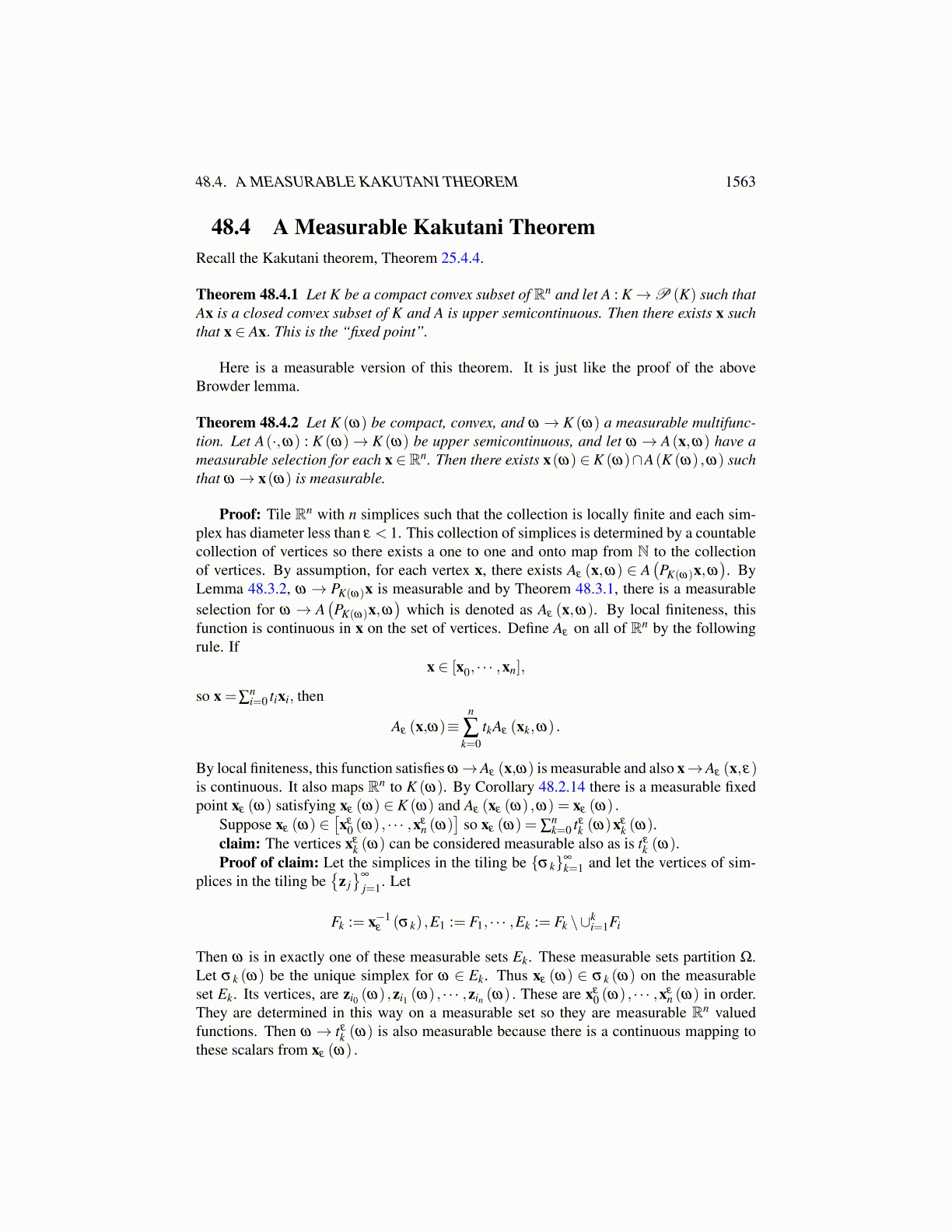
48.3. A SET VALUED BROWDER LEMMA WITH MEASURABILITY 1563
This requires(y(ω)−
(B̂ε (xε (ω) ,ω)+Ĉε (xε (ω) ,ω)
),z−xε (ω)
)Rn ≤ 0 (48.3.12)
for all z ∈ θ (ω)−1 K (ω) . Note that this implies ω → B̂ε (xε (ω) ,ω) ,Ĉε (xε (ω) ,ω) aremeasurable because of the continuity in first argument and measurability of ω → xε (ω)
We have
xε (ω) =n
∑k=0
tεk (ω)xε
k (ω) (48.3.13)
where the xεk (ω) are vertices of the tiling corresponding to ε .
Claim: The vertices xεk (ω) and coordinates tε
k (ω) can be considered measurable.Proof of claim: Let the simplices in the tiling be {σ k}∞
k=1 and let the vertices of simplicesin the tiling be
{z j}∞
j=1 . Say the vertices of σ k are{
xk0, · · · ,xk
n}
listed in the order of thegiven enumeraton of vertices of simplices in the tiling. Let Fk and Ek be defined as follows.
Fk ≡ x−1ε (σ k) ,E1 ≡ F1, · · · ,Ek ≡ Fk \∪k−1
i=1 Fi
Then each ω is in exactly one of these measurable sets Ek which partition Ω. For ω ∈Ek,xε (ω) ∈ σ k (ω). Thus σ k (ω) is the first simplex which contains xε (ω) and the or-dered vertices of this simplex are constant on the measurable set Ek. These vertices aredetermined this way on a measurable set Ek and so they must be measurable Rn valuedfunctions. Then ω → tε
k (ω) is also measurable because there is a continuous mapping tothese scalars from xε (ω) which was obtained measurable. This shows the claim.
Recall 48.3.10. Let Wε (ω) be defined as follows.
Wε (ω)≡(
tε0 (ω) , · · · , tε
n (ω) ,xε0 (ω) , · · · ,xε
n (ω) ,xε (ω) ,wεB
0 (ω) , · · · ,wεBn (ω) ,wεC
0 (ω) , · · · ,wεCn (ω)
)This is in R2(n+1)× (V ′)2(n+1). Then by Theorem 48.2.2, since Wε (ω) is bounded in areflexive separable Banach space, there is a subsequence ε (ω)→ 0 such that Wε(ω) (ω)→W(ω) weakly and given by
W(ω)≡(
t0 (ω) , · · · , tn (ω) ,x0 (ω) , · · · ,xn (ω) ,x(ω) ,wB
0 (ω) , · · · ,wBn (ω) ,wC
0 (ω) , · · · ,wCn (ω)
)where each of these components is measurable into the appropriate space. Of course, inthe finite dimensional components, the convergence is strong because strong and weakconvergence is the same in finite dimensions. Since the diameter of the simplex containingthe fixed point xε(ω) (ω) converges to 0, it follows that
limε(ω)→0
xε(ω)k (ω) = x(ω)
By upper semicontinuity, for A = B,C, it follows that Â(
xε(ω)k (ω) ,ω
)⊆ Â(x(ω) ,ω)+
B(0,r) for all ε (ω) small enough. Since, by the construction,
B̂ε(ω)
(xε(ω)
k (ω) ,ω)= θ (ω)∗ i(ω)∗wε(ω)B
k (ω) ∈ B̂(
xε(ω)k (ω) ,ω
),